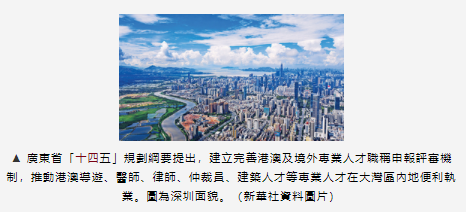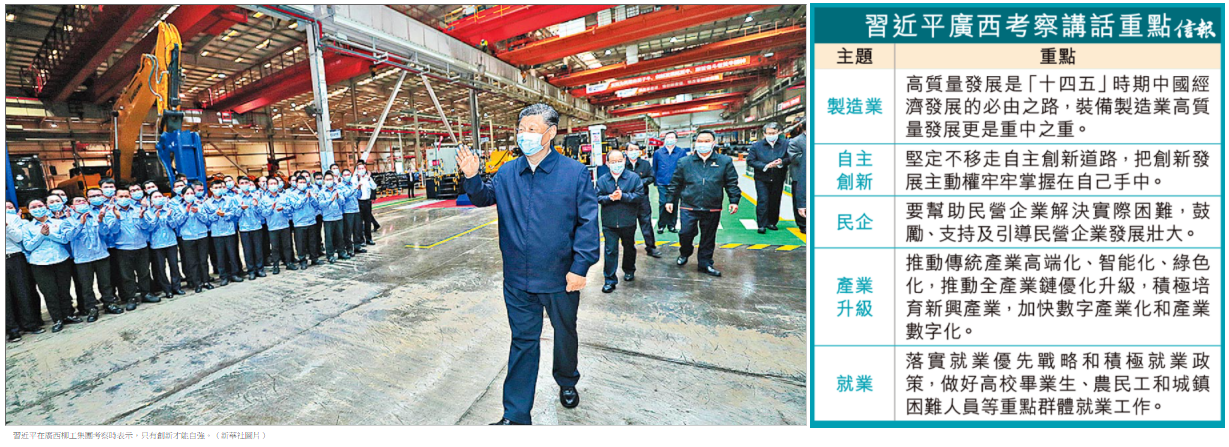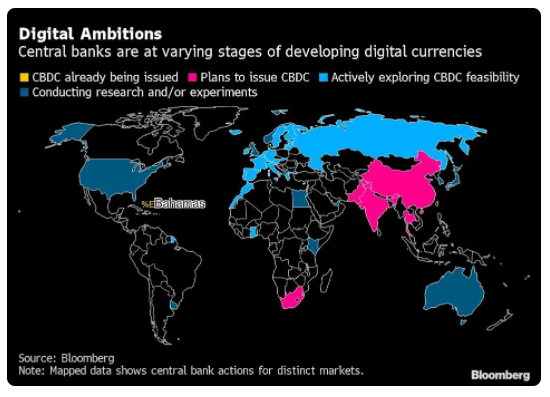2021年4月30日
行業報導 - 2021年4月30日
1、粵「十四五」規劃出爐 擴對港澳服務業開放
【本報訊】廣東省昨日發布「十四五」(2021-2025)規劃綱要提出,深化廣東自貿試驗區制度創新,進一步擴大對港澳服務業開放,推動具有港澳執業資格的建築、會計等專業人士經備案後直接執業。
推動建築會計等專才執業
綱要稱,支持粵港澳大灣區內地企業使用香港的檢驗檢測認證等服務。支持引進港澳成熟生活性服務業,加強健康服務、家庭服務、文化旅遊等服務業合作。建立完善港澳及境外專業人才職稱申報評審機制,推動港澳導遊、醫師、律師、仲裁員、建築人才等專業人才在大灣區內地便利執業。
在推進粵港澳跨境要素便捷流動方面,廣東「十四五」規劃提出,將大力實施「灣區通」工程,聚焦食品安全、環保、旅遊、醫療、交通、通關等重點領域,以點帶面、深入推動三地規則銜接。推進粵港、粵澳口岸基礎設施建設,推廣實施「一地兩檢」「合作查驗、一次放行」等人員通關新模式,研究探索建立大灣區人才綠卡制度。
探索檢驗平台 食安數據共享
規劃綱要還提出,推動粵港澳大灣區標準化研究中心建設,制定實施推廣「灣區標準」;探索搭建大灣區食品標準體系和檢驗監測平台,推動實現食品安全監管數據共享;推廣「圳品」供深食品標準模式,打造大灣區食品區域品牌,探索建立大灣區食品團體標準;推動建設粵港澳大灣區國際仲裁中心等。
規劃綱要又提出廣東省「十四五」時期經濟社會發展的主要目標,其中經濟發展邁上新台階,在質量效益明顯提升的基礎上,全省GDP年均增長5.0%左右,到2025年GDP約為14萬億元人民幣。
資料來源:香港經濟日報 (2021年4月26日)
2、習促裝備製造業高質量發展 推動產業升級 牢握創新主動權
據內地官媒報道,國家主席習近平在廣西考察時指出,高質量發展是「十四五」時期中國經濟發展的必由之路,裝備製造業高質量發展更是重中之重。他強調,只有創新才能自強、才能爭先,在自主創新的道路上要堅定不移、再接再厲、更上層樓。他在考察柳州螺螄粉產區時強調,要鼓勵民營企業發展,希望民企放心大膽發展。
習近平周一(26日)在廣西柳工集團考察時指出,建設社會主義現代化強國、發展壯大實體經濟,都離不開製造業,要在推動產業優化升級上繼續下工夫,堅定不移走自主創新道路,把創新發展主動權牢牢掌握在自己手中。據柳工集團官網,該集團是中國機械工業百強企業,全球有20個製造基地,覆蓋挖掘機、鏟運機、農業機械等13大類整機產品線,裝載機銷量全球第一。
盼民企放心大膽拓展
習近平亦考察了柳州螺螄粉生產集聚區,他談及民營企業發展稱,「小米粉大產業,民營企業敢於闖。我們鼓勵民營企業發展,黨和國家在民營企業遇到困難的時候給予支持、遇到困惑的時候給予指導,就是希望民營企業放心大膽發展。」國企方面,他則提到,要堅持共產黨對國有企業的全面領導,堅持加強黨的領導和完善公司治理相統一,在深化企業改革中搞好黨的建設,充分發揮黨組織在企業改革發展中的領導核心作用。
他在聽取廣西政府工作滙報後表示,要推動傳統產業高端化、智能化、綠色化,推動全產業鏈優化升級,培育新興產業,加快數字產業化和產業數字化。
支持脫貧地區特色產業
要主動對接長江經濟帶發展、粵港澳大灣區建設等國家重大戰略,融入共建「一帶一路」,高水平共建西部陸海新通道,大力發展向海經濟,促進中國-東盟開放合作,辦好自由貿易試驗區,把獨特區位優勢更好轉化為開放發展優勢。
習近平還強調鄉村振興和就業。他稱,要加快推進鄉村振興,健全農村低收入人口常態化幫扶機制,繼續支持脫貧地區特色產業發展,要嚴格實行糧食安全黨政同責,壓實各級黨委和政府保護耕地的責任,穩步提高糧食綜合生產能力;就業方面,要落實就業優先戰略和積極就業政策,做好高校畢業生、退役軍人、農民工和城鎮困難人員等重點群體就業工作。
資料來源:信報財經 (2021年4月28日)
3、路透社:香港漸成深圳「後院」 兩地角色大逆轉?
粵港澳大灣區戰略加快推進,香港與內地交往將更頻繁。路透社報道,內地房地產開發商漸將目光投向香港的邊境地區,因爲深圳的內地人士認爲,香港部分區域成爲較能負擔的長期住房選擇。
這類開發計劃被一些人視爲一個轉折點:深圳以前被看作是香港成本便宜的工業腹地,如今愈來愈多來自深圳的購房者,卻將全球金融中心香港視爲深圳的「後院」。
與香港近年遭遇種種事件相比,深圳的地位被指正在不斷上升。去年10月,國家主席習近平在深圳發表講話時稱其爲「模範城市」,並計劃把外國投資者引進來。
短短幾十年時間,這個位於國土南疆的地方,已經變成了擁有約1,300萬人口的科技中心,發達程度遠超仍然遍布魚塘農田、開發力度被指不足的香港北部區域。目前每年仍有數十萬人口遷入深圳。
在深圳的黃金地段,譬如科技巨頭騰訊 (0700) 總部所在的南山區,一些房子的價格已經超過了香港北部。香港北部距離中心商務區至少一個小時的車程。
「深圳將成爲中心 香港變成外圍」
「我們的長期看法就是,深圳將成爲中心,而香港變成外圍」,一家曾經在不太有吸引力的北部區域購地的中資房地產公司的高管說。由於無權向媒體發表談話,這位高管要求不具名。
深圳的上班族可能選擇住在香港房價較便宜的地區通勤上班。
為了呼應內地客的「香港居住、內地上班」需求,房產經紀人對路透社稱,恒大集團 (3333) 計劃在元朗建設大約200套房屋,預計大部分買家來自內地。一名與恒大有接觸的經紀稱,該公司以每平方尺1萬港元的價格購入土地,計劃售價2萬港元/平方尺,希望吸引來自深圳的購房者。
在深港交界處附近,房價已經接近3萬港元/平方尺。據稱,多間地產商亦已瞄準內地客,對香港北區住房的需求。
資料來源:香港經濟日報 (2021年4月27日)
4、科技園夥工總 設「研發共創平台」
本港近年積極推動創科發展,當中再工業化是其中一項支柱。香港科技園公司及香港工業總會昨宣布成立「研發共創平台」,參與計劃的工總會員能夠使用科學園的工作空間,並可使用園區各種實驗室、增值服務等。
現時已有7間公司申請,有申請計劃的電子加工企業希望與科學園區內的硬件供應商合作,開發用於寵物的人工智能系統。
8工作間 每個月租約1.4萬
研發共創平台位於科學園生物資訊中心,佔地約3,500呎,有8個工作間,每個月租約1.4萬元。參與的工總會員同時可使用科學園設施,包括共享實驗室、會議室、科技團隊支援,並與園區內1,300多公司聯繫,可以園區公司身份申請創新科技署「研究人才庫」,獲資助聘研究員。
科技園公司行政總裁黃克強表示,計劃會由科技園公司負責審批,參與公司必須至少有一半員工專注於研究及產品開發(R&D)工作,科技園亦會每年評估參與企業是否有足夠投入在開發上,以商討續約。他透露現已有7間公司申請,倘反應熱烈或會推新一期計劃。
香港工業總會主席葉中賢表示,近年港資廠商遇到中美關係、新冠肺炎等挑戰,更積極尋找出路,57%會員有意增加科技研發上的投資,亦有37%廠商在港設立了科研團隊。他期望計劃能夠幫助廠商與創科企業緊密合作,結合工業家的產業化經驗,及園區內的新技術和應用。
老牌公司 借園區資源擴展
參與計劃的信佳國際集團有限公司,主要在內地設廠做電子加工,董事吳民卓表示,公司正開發具附加價值的產品,如用於寵物的面部辨識人工智能,方便獸醫辨識動物種類和查閱病歷,可用於不需要植入晶片的寵物如貓隻。他指,老牌公司難以直接投放大量資源到開發上,相信計劃能幫助他們先借用園區的資源,包括與園區內的處理器製造商合作,增強人工智能的運算能力,當有研究成果時就能夠進一步擴大研發團隊。
資料來源:香港經濟日報 (2021年4月30日)
5、不甘讓渡貨幣控制權 全球央行數字貨幣研發駛入「快車道」
【彭博】-- 隨著英國央行和財政部周一宣布將成立工作組探索數字貨幣,歐洲央行本月公佈了作為如何設計數字歐元重要參考的公眾諮詢報告,越來越多的貨幣當局已加快步伐研究央行數字貨幣。
雖然各國政府在加密貨幣誕生之初大多不屑,但在主流基金開始投資比特幣、加密貨幣交易所上市、Facebook Inc.持續推進其加密貨幣項目的情況下,在全球範圍內使用某種替代貨幣的概念本身已讓各國監管機構認為,這可能是對國家主權、隱私、金融穩定和央行實施貨幣政策的能力的一種威脅。
國際清算銀行(BIS)今年1月發布調查報告,稱去年全球有86%的央行正在研究央行數字貨幣(Central Bank Digital Currency,簡稱CBDC),部分已經發布了深度評估並且測試了不同的設計,相比之下,2017年的這一比例約在65%。
布魯金斯學會的高級研究員David Dollar今年早前曾表示,這些貨幣當局的努力是防禦性質的,央行正試圖拿回控制貨幣和貨幣供應的主導地位。
有些央行可能擔心,除非自己提供數字加密貨幣,否則會逐漸失去對貨幣狀況的控制。例如,如果支付完全轉向Diem,可能意味著Facebook對貨幣環境擁有不應有的影響力。
億萬富翁對沖基金創始人Ray Dalio曾表示,如果他是央行,就不會允許有任何私人數字貨幣。
事實上,通過用於貨幣政策目的的銀行準備金,金融機構已經可以使用數字央行貨幣。正在討論之中的真正可能產生顛覆性的問題是,央行是否應該使用新技術向公眾提供這種貨幣,即零售型CBDC。
Bloomberg Intelligence金融科技分析師Julie Chariell稱,CBDC或削弱比特幣作為所謂的P2P現金系統的提議用途。CBDC不具有比特幣那種供應有限和匿名的特性,但是穩定性和易用性將增強它們用於支付的吸引力。其可能讓比特幣在儲值和有用的通膨對沖工具方面退至一個重要但較小的角色。
各地進展
巴哈馬:已於去年10月推出數字沙元(Sand Dollar),是全世界首個正式推出的主權信用的數字貨幣。
瑞典:央行行長本月稱,或將在五年內推出數字貨幣,這是該國央行在2016年提出計畫推出零售型CBDC後首次給出時間表。作為世界上最古老的央行,Riksbank最近承認明年初前不能完成當前的試點。
中國:先在深圳、蘇州、成都、雄安和北京冬奧會場五地通過大型銀行開展試點,後又增加了上海、海南、長沙、西安、青島、大連六個試點測試地區。
歐元區:歐洲央行尚未決定是否推出數字歐元,該行上周發布了數字歐元公眾諮詢報告,受訪者對任何一種新形式的歐元最為看重的是隱私功能。這項諮詢是決定未來設計的重要起點。歐洲央行管理委員會將在2021年年中決定是否對數字歐元的推出開啟正式調查階段。現任歐洲央行總裁的拉加德曾在擔任IMF總裁期間呼籲全球央行研究發行數字貨幣。
英國:財政部和央行周一表示,將成立一個工作組,探索中央銀行數字貨幣,但尚未就是否發行數字貨幣做出決定。如果最終獲得相關方面同意,「數字貨幣將於現金和銀行存款共存,而非取代它們。」
美國:聯儲會主席鮑威爾本月表示正進行大規模的研發項目,但是數字美元是否會給民眾帶來好處這個問題尚未解決。財政部部長耶倫2月份表示,數字美元可有助於解決在美國低收入家庭實現金融普惠的障礙,較其前任姆努欽的冷淡態度有所轉變。
日本:該國央行3月表示,將自這個春天起開啟第一階段的概念驗證以開始探索數字貨幣的可能性,但目前尚未有計畫推出數字貨幣。
加拿大:央行副行長Tim Lane去年表示,雖然發行數字貨幣在當前階段並不必要,但需要研究一個可能的央行數字貨幣會是什麼樣的以及如何管理。這為能適時推出打下基礎。
根據普華永道的報告,目前探索數字貨幣的央行中,在零售型CBDC項目的成熟度方面,中國排在第三位,僅次於巴哈馬和柬埔寨;在銀行間,即躉售型CBDC項目中,泰國和中國香港並列排名第一,其次是新加坡、加拿大和英國。
全球央行可以選擇直接發行數字貨幣,也可以通過銀行等機構支付服務提供商發行。中國和瑞典央行則將這兩種方式混合,即將零售支付和線上解決方案外包給銀行或其他支付服務提供商,同時央行保留所有數字交易的備用底賬。用戶在交易中是匿名的,參與交易的商業銀行部分可見,央行完全可見。
參考閱讀:
Bank of England Joins Global Peers Exploring a Digital CurrencyWhy Central Bankers Got Serious About Digital Cash: QuickTakeSweden’s Central Bank May Have a Digital Currency in 5 YearsGLOBAL INSIGHT: Carpe Diem - Central Banks in Digital FutureWhy Tomorrow’s Money Will Come in New Crypto Flavors: QuickTake
©2021 Bloomberg L.P.
資料來源:hk.news.yahoo.com (2021年4月27日)
6、Vietnam sees modest growth in Q1 textile exports
Vietnam’s textile export turnover in the first quarter has seen modest growth but is showing signs of recovery.
Read More: https://www.just-style.com/news/vietnam-sees-modest-growth-in-q1-textile-exports_id141264.aspx
Source: www.just-style.com (26 Apr 2021)
7、Pandemic and shifts in sourcing threaten Bangladesh's position
Rapid growth, modernisation and improved working conditions have all helped to make Bangladesh one of the world’s largest garment exporters. Yet the industry will need to innovate, upgrade and diversify if it is to overcome the challenges brought on by the pandemic and shifts in global markets, a new report has found.
Source: www.just-style.com (27 Apr 2021)
8、RCEP trade pact hands China a global edge, for now
TOKYO -- The world's largest trade pact that encompasses 30% of the global economy is set to come into force as early as this year.
The Regional Comprehensive Economic Partnership, or RCEP, was ratified in Japan's upper house of the Diet on Wednesday, bringing it one step closer to reality.
China has already assumed a leadership role in the arrangement and will inevitably see its clout increase over the Asian economic order. The U.S. and Japan need to come up with new ideas.
The agreement includes the 10 member countries of the Association of Southeast Asian Nations as well as China, Japan, South Korea, Australia and New Zealand.
Zbigniew Brzezinski, the national security adviser under former U.S. President Jimmy Carter, once called Eurasia the "grand chessboard" pitting the Soviet Union against the West. To borrow from that metaphor, a grand board of "go" or "wei chi" is developing in the Asia Pacific region. The economic turf battle between China and the free world is growing in intensity.
Under President Barack Obama, the U.S. strove to launch the Trans-Pacific Partnership (TPP) as a means to harness China's ever growing influence. That strategy fell apart when President Donald Trump took the nation out of the pact in 2017.
Japan worked hard to salvage the TPP and put together an 11-member deal, reframed as the Comprehensive and Progressive Agreement for Trans-Pacific Partnership.
But without the U.S., the bloc suddenly became a more modest affair, covering just over 10% of the global economy.
This provided an opening for China to strike back, through RCEP.
Under RCEP, member states will abolish tariffs on 91% of goods, notably lower than the 99% threshold in the TPP. By lowering the bar, China put emphasis on allowing as many countries as possible to enter, thereby taking the initiative of the pact. The opening chapter of this tale has been all China.
Japan suffered a major setback when India decided not to join RCEP. Tokyo had hoped that the South Asian country would serve as a counterweight to China's outsize influence. Yet, due to a fear of Chinese goods flooding the market, India chose not to participate.
An intense debate took place within the Japanese government over whether to support a China-led RCEP. But the concern over a new economic order emerging without Japan's involvement won out in the end.
The next move is tricky. Japan continues to lobby India to join the RCEP, but that ship looks to have sailed.
"I sense no enthusiasm from the Modi administration," said a senior official in Japan's Ministry of Economy, Trade and Industry, speaking of Indian Prime Minister Narendra Modi.
Over in the U.S., President Joe Biden is pursuing a "foreign policy for the middle class" that prioritizes the interests of ordinary citizens and workers. Biden said he will not sign any major trade deal that does not have the support of the American people, emphasizing the he will only ink agreements in which labor unions and similar stakeholders are involved in the decision-making process.
This indicates that Biden faces a large hurdle in joining the CPTPP, which has been criticized for favoring big corporations.
Still, Japan and other Asian countries that uphold principles of economic liberalism and democracy do not wish for an economic order in which China holds great sway and is infiltrated by its state capitalist policies.
To prevent that outcome, the U.S. will need to be involved economically in the region and some way must be found to strengthen coordination among allies and friendly nations.
There are two things that can be accomplished near term.
One is to forge a multilateral economic accord based on a new concept. Conventional trade pacts, including the TPP, are written with a focus on goods and tend to exacerbate clashes of interests between nations and industries.
While such agreements do have an effect of liberalizing trade and initiating economic reforms in the long run, under the new reality that the U.S-China rivalry has ushered in, it would be realistic to start from areas where all parties can easily agree on.
Jake Sullivan, the U.S. national security adviser and co-architect of the "foreign policy for the middle class," advocates for a departure from economic diplomacy biased toward trade in the manufacturing industry and highlights the importance of the service sector. Sullivan says there is room to consider a different type of accord.
Matthew Goodman, senior vice president at the Center for Strategic and International Studies, points to the possibility that the U.S. could gather like-minded countries to create rules covering digital technology, data and e-commerce. Such regulations are already in the works in the World Trade Organization and the Asia-Pacific Economic Cooperation, and these efforts could translate into a comprehensive agreement.
A deal governing the digital space would curb tensions over how a limited pie is divided up. Making rules for the new era would also serve as a catalyst for transforming the economy.
Another immediate pathway to contain China's influence is to strengthen economic ties between the Quad nations of the U.S., Japan, India and Australia.
The Quadrilateral Security Dialogue is a framework that deepens regional cooperation between members of the free world. It has been a poster child for the "free and open Indo-Pacific" concept led by Tokyo and Washington.
But as of now, the Quad has leaned heavily toward security, such as conducting the Malabar joint exercises in the Bay of Bengal and the Arabian Sea last November.
If Quad activities expand into the economic arena, the approach could become an effective tool to encourage liberal economies to firmly take root in Asia, including the region's smaller countries. The four countries are already starting to collaborate on important infrastructure, such as data communication and energy, through relevant organs.
Quad leaders confirmed that they will deepen dialogue on vital high-tech supply chains during the maiden summit in March. If efforts to create a "China-free" supply chain accelerate, India anticipates taking on a portion of that itself. European countries are showing growing interest in the Quad as well.
At this stage of the game, the great power competition has only been local skirmishes. But going forward, the chess board, or "go" board, will quickly expand.
To challenge China, the liberal block needs a grand strategy. It will need to place the go pieces carefully yet creatively, with an eye on multiple countries as well as the economic and security frameworks of the region.
Source: https://asia.nikkei.com (29 Apr 2021)
9、Textiles 2030 launches to cut UK clothing impact
UK waste recycling charity WRAP has officially launched its ten-year voluntary clothing and textile waste programme today (26 April), which aims to slash the environmental impact of UK clothing and home fabrics through practical interventions along the entire textiles chain.
Read More: https://www.just-style.com/news/textiles-2030-launches-to-cut-uk-clothing-impact_id141256.aspx
Source: www.just-style.com (26 Apr 2021)
10、Monki’s New App Connects Consumers to H&M Group’s Garment Care Service
Consumer engagement is key in the aftermath of a global pandemic, and H&M Group’s Scandinavian-cool brand Monki is making sure it has shoppers’ full attention. It recently launched a new app in Sweden as part of its ongoing work to engage with its community and offer ways of interacting with the brand and each other.
The app is an accessible platform for Monki to share its “Planet Power” strategy of sustainability efforts and conscious initiatives that span a pivot to 100 percent certified organic cotton for its denim range, to call to actions to reuse and recycle.
Sustainability is at the crux of Monki’s latest projects. At the end of 2020, Monki dropped a capsule collection made from upcycled denim featuring sustainable elements such as recycled thread and zippers and eco-friendly hardware, further underscoring its push for extending denim’s lifecycle and breathing new life into old pieces.
One of the unique benefits of the app is that consumers can connect to M.IN.T. Care, a fashion care initiative within the H&M group. Short for “More INspiration To Care,” M.IN.T allows customers to order wash, repair or redesign services for their garments directly from their home. Consumers simply log in, select the items that need mending or washing, pack up the order and ship it off.
The services are provided by M.IN.T. Care partner, Washawell, a Swedish laundry company that uses environmentally friendly detergents and dry cleaners. Repair and alterations services are currently only available in Sweden, and the wash services are only available in Stockholm. The program, however, plans to expand geographically together with its stakeholders.
Monki’s app also serves as a hub for fans to mingle virtually. Described as a “digital [haven] for fashion inspiration and community interaction,” the app offers users the ability to access the “Monkisphere,” where they can share fashion inspiration, enter competitions and directly connect with the brand.
Users can also find and unlock unique in-store offers by using the scanning function within the app.
Source: www.sourcingjournal.com (26 Apr 2021)
11、Li & Fung’s LFX Launches ‘3D-as-a-Service’ Tech Venture
Although supply chain titan Li & Fung Ltd. just launched its LFX offshoot earlier this month in efforts to accelerate supply chain digitization, the new incubator is wasting no time putting these plans into action by launching a new service.
LFX has launched UNIFi3D, a “3D-as-a-service” technology company aimed at helping fashion brands transition to creating and selling products digitally—which the company refers to as digital product creation and commerce (DPCC). UNIFi3D is built to work directly with apparel brands and retailers to guide them at all steps of the 3D design process, whether they’re just getting started or attempting to scale ongoing efforts.
Idy Lee, formerly head of Li & Fung’s Digital Product Development Center of Excellence, will lead UNIFi3D as head of services, bringing her team of 3D and supply chain experts into the program. Going forward, UNIFi3D will serve as the primary arm of Li & Fung to provide 3D services to its customers.
“While 3D is the first step to digital transformation, it requires a technology savvy workforce,” Lee said in a statement. “Apparel brands, however, are built by creative, artistic people with vision—not technologists. Brands who partner with UNIFi3D benefit from our product development expertise and manufacturing know-how, while their designers continue to provide the creative vision.”
The company boasts more than 100,000 digital library assets, 500,000 total digital images made, 20,000 unique SKUs and more than 50 product categories.
“The UNIFi3D team has been providing industry-leading digital product creation and commerce services for 100+ apparel brands during the last three years as part of Li & Fung,” said Ed Lam, CEO of LFX, in a statement. “As an LFX company, UNIFi3D has the most experienced 3D team providing direct services to accelerate apparel brands’ transition to creating and selling products digitally at scale.”
LFX says that the UNIFi3D service can reduce product development time by as much as 70 percent, dramatically accelerating time-to-market and enabling brands to respond more quickly to consumer trends.
Images created via the service are designed to be viewed so that brands can test the market with 3D products without expensive photoshoots, ideally making it easier to move from line review to e-commerce and marketing.
With this in mind, UNIFi3D also seeks to help brands begin sales and marketing efforts prior to the manufacturing process for increased sell-through. Even while increasing sell-through, the service aims to eliminate or reduce physical samples to drive sustainability initiatives and minimize waste.
The 3D product components that brands can provide to UNIFi3D at the start include block/2D pattern, tech pack, digital avatar, fabric swatch, trims and artwork. If a brand doesn’t already have these, UNIFi3D will either help them identify sources or help them create them.
Brands don’t even need to know how to use 3D software upon working with UNIFi3D, which provides all 3D services, including revisions. Users can send feedback, comments and revision requests to UNIFi3D.
As part of its mission to help retailers in the digital product creation process, UNIFi3D also provides 3D education services to its client base, focusing on how to ensure the successful adoption of this technology.
Workshops help brands avoid the common pitfalls for transitioning to DPCC, as well as learning the different ways 3D products can be used to identify market trends, gain greater confidence in buy-orders, and how to better coordinate between sourcing, merchandising, design and e-commerce teams.
First-time visitors to the UNIFi3D website are greeted with a chatbot that asks “What would you like to improve in your business?” and gives three options: get products to market fast, increase regular sell-thru and reduce carbon footprint. From there, the bot asks where visitors are in their product journey before requesting a name and email, where a rep will make the contact for an initial consultation.
UNIFi3D is the first major project launch from LFX, which is designed to serve as incubation, investment and operating platform that covers all aspects of the value chain, including trade, information and fund flows. Li & Fung noted during the LFX launch that its initial ventures focused on 3D digital product development, now revealed to be UNIFi3D, and supply chain fintech.
As part of its investment goals, LFX also has a venture capital arm to identify and invest in technologies transforming global retailing, supply chain and logistics.
The LFX launch comes less than a year after JD.com invested $100 million in Li & Fung, giving the company significant capital to further develop the digital supply chain.
Source: www.sourcingjournal.com (28 Apr 2021)
12、Fung Business Intelligence : Asia Sourcing Update - Southeast Asia
Asia Sourcing Update - Southeast Asia (Cambodia, Indonesia, the Philippines, Thailand and Vietnam)_April 2021
https://www.fbicgroup.com/sites/default/files/ASU_SE_Asia_202104.pdf
For more Fung Business Intelligence publications, please visit: https://www.fbicgroup.com/?q=reports
Source: Fung Business Intelligence (28 Apr 2021)













